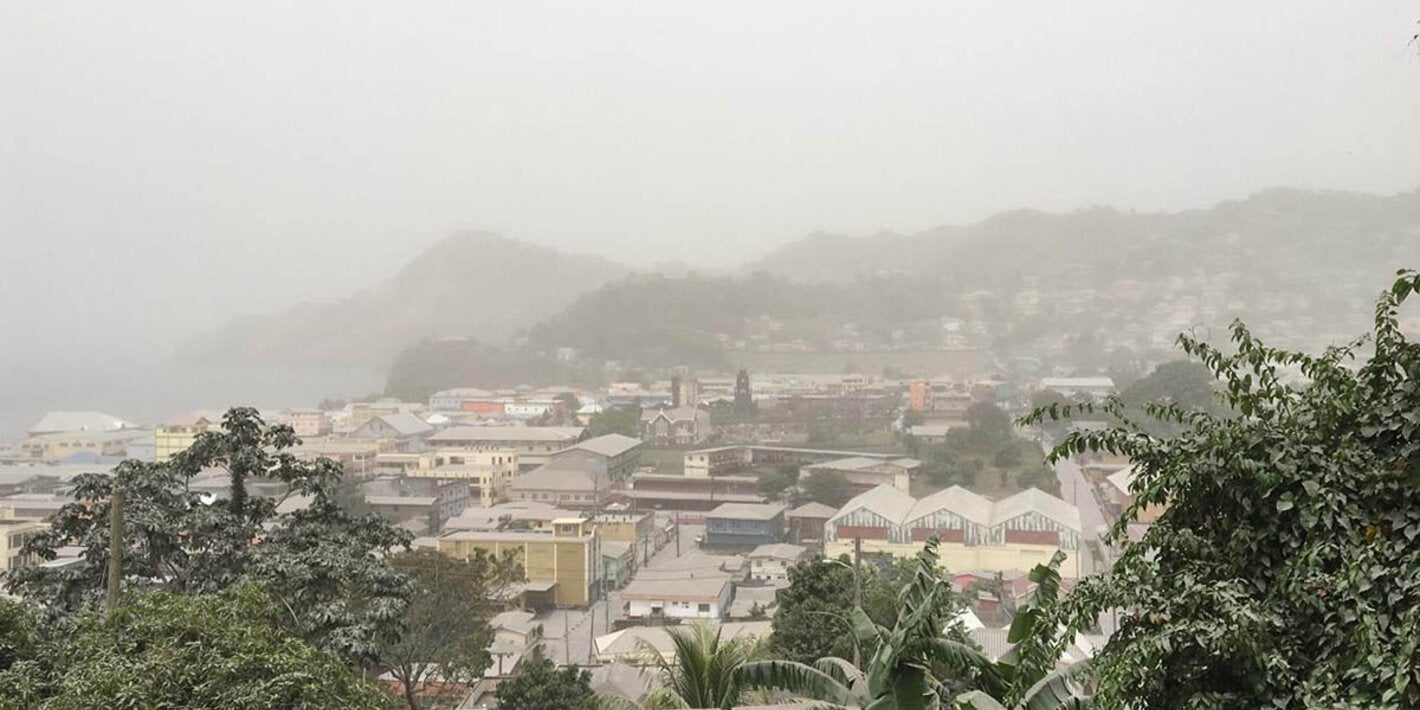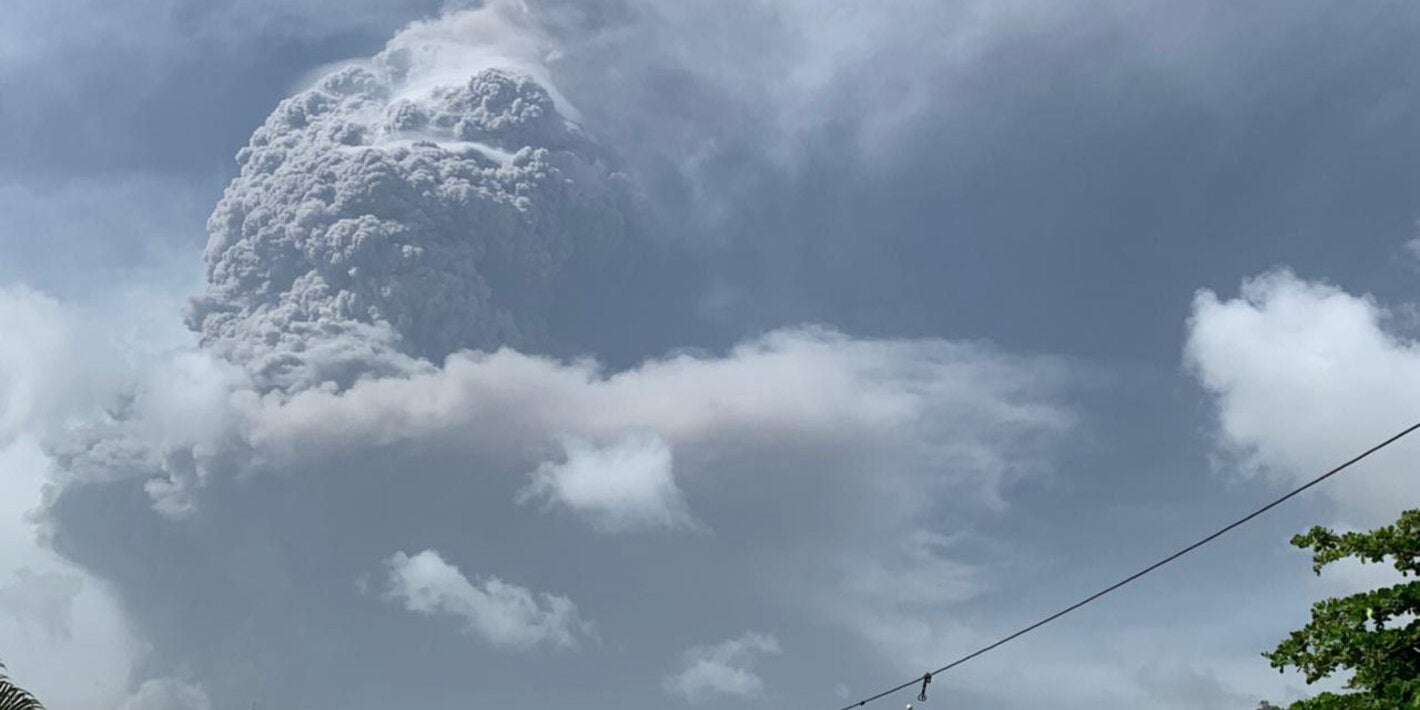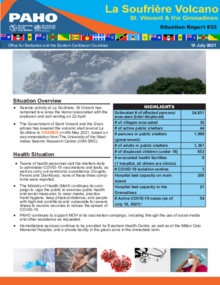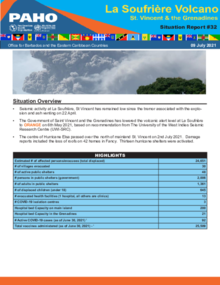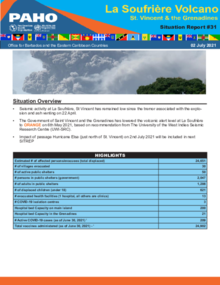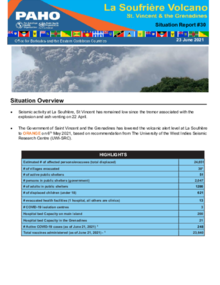When volcanoes are inactive, people can underestimate the risk, especially if they do not know about volcanic hazards. This increases vulnerability, especially in communities living on or near the volcano.
Volcanoes can have different styles of eruption. Some volcanoes generate pyroclastic flows, ballistic blocks and ash that can fall on communities, like at Fuego in Guatemala, Soufrière Hills, Montserrat and La Soufriere, St Vincent; others produce lava flows (for example, Hawaii). Sometimes mudflows (lahars) are generated when magmatic heat thaws ice, as happened in Colombia with the eruption of Nevado del Ruiz. Other times, mudflows occur when heavy rain mobilizes volcanic sediment on the volcano’s slopes. The most common effects on health caused by volcanic eruptions include traumatic injuries, burns, suffocation, skin irritation, eye injuries and conjunctivitis, respiratory problems, and even death.
Volcanic emissions (ash and gas) may impact food and water supplies as well as affecting livestock and domestic animals, crops and the environment. They may also impact basic services (water, transport, communications) and access to health services. The accumulation of ash on roofs can cause damage or collapse of buildings, both immediately and after the event, during the cleaning-up phase. Accidents, with multiple injuries, due to roof collapse are common.
Health facilities can be destroyed, or their operation compromised, restricting access to basic services. To minimize disruption, preparedness for an eruption should involve set up of monitoring, knowledge of the different eruptive scenarios, permanent communication with technical authorities, alert systems, advanced preparations, and trained and properly equipped personnel.
Local authorities and the responsible civil and technical protection entities are fundamental partners in providing advice on the type of eruption that is expected, which allows preparation for an appropriate response and prevention of damage and losses.
Types of eruptive events
Volcanic ash is not ash at all. It is pulverized rock. A one-inch layer of dry ash weighs ten pounds per square foot as it lands. It often contains small pieces of light, expanded lava called pumice. Fresh volcanic ash may be harsh, acid, gritty, glassy, smelly, and thoroughly unpleasant. Although gases are usually too diluted to constitute a danger to a healthy person, the combination of acidic gas and ash which may be present within a few miles of the eruption could cause lung damage to small infants, elderly and susceptible, or those already suffering from severe respiratory illnesses.
- A heavy ashfall blots out light. Sudden heavy demand for electric light may cause power supplies to burn out or fail.
- Ash clogs water courses, sewers, sewage plants and machinery of all kinds.
- Ash drifts onto roadways, cartways and runways like snow, but resembles soft sand.
- Fine ash may be slippery.
- The weight of ash may cause roofs to collapse.
- In case of moderate or abundant ashfall, especially fine particles, bronchial asthma, and other chronic respiratory conditions may be aggravated, in children as well as in adults.
- Death is highly improbable, although it could occur in persons with serious symptoms if they do not protect themselves from the ashes.
- Ash particles are abrasive and can also cause abrasions in the cornea.
- Follow the recommendations of the emergency authorities.
- Do not panic, stay calm – for healthy people ash is more bothersome than hazardous to your health but you should minimize exposure to ash.
- Stay indoors until the heavy ash is settled.
- If caught outside, stay covered and seek shelter.
- While outside, use a mask, if available, or a handkerchief/cloth and protect the eyes, the skin, and cover the head.
- Use the phone only if it is essential.
- Use your radio for information on the ashfall.
- Follow the recommendations of the emergency authorities.
- You should minimize exposure to ash, staying indoors as much as possible.
- Seek health care if chest or respiratory symptoms develop.
- The most effective protection is to use a lightweight high efficiency mask (such as an N95 mask) or a common surgical mask.
- Ensure a good fit of the mask to the face by adjusting nose clips and straps.
- Use the same mask until it is visibly soiled or damaged.
- Protect the eyes, the skin, and cover the head.
- Remove contact lenses and use glasses when possible.
- Minimize ash from entering the home:
- Close doors and windows and seal off the chimney opening.
- Place wet towels at the bottom of doors and other places where there are drafts.
- Minimize use of forced air heaters, air conditioners, or clothes dryers.
- Do not operate fans.
- Protect your water source from ash contamination. If the water has an acid taste or smell, use bottled water.
- Remove ash from fruits and vegetables by washing them thoroughly.
- Use a battery-operated radio for information.
People should know that breathing ash could be harmful and protection is advised for everybody. For the general population that must leave their homes for short periods, any type of common surgical mask should be efficient. Ensure a good fit of the mask to the face by adjusting nose clips and straps. Two types of population should be considered for special respiratory protection advice:
- People who work outside and are heavily exposed to ash (e.g. cleaning crews, emergency and rescue teams, police).
- People who are more vulnerable to ash particles (e.g. serious medical conditions, asthma sufferers, children, elderly).
|
CONSEQUENCES |
IMPACT ON THE COMMUNITY |
PREVENTIVE MEASURES |
|---|---|---|
|
Respiratory |
||
|
Inhalation of fine ash (<10 microns in diameter) |
Asthma, exacerbation of pre-existing lung disease |
Laboratory test for particle size; Wear high-efficiency masks; Protect homes/offices from ash infiltration |
|
Inhalation of siliceous dust (presence of crystalline silica, e.g., cristobalite, quartz) |
Risk of Silicosis, if exposure heavy and continuous (years): an outdoor occupational hazard |
Laboratory tests for crystalline silica, respiratory protective equipment |
|
Gastrointestinal |
||
|
Ingestion of water contaminated with fluoride, possibly also heavy metals |
Gastrointestinal upset, even death in vulnerable (chronic sick) |
Laboratory tests for leachable toxic elements; avoid surface waters for drinking supplies (i.e., use well water) |
|
Ingestion of contaminated food (as above), including milk |
As above |
Laboratory tests for bioavailability of toxic elements; Observe health of foraging animals, laboratory analyses of milk |
|
Ocular and Skin |
||
|
Foreign bodies in eyes |
Conjunctivitis, corneal abrasions |
Goggles for heavily exposed (e.g., outdoor workers) |
|
Acid rain
|
Eye and skin irritation; Possible toxic contamination | Laboratory tests for bioavailability of toxic elements; Observe health of foraging animals, laboratory analyses of milk |
| Ash exposure | Skin irritation |
Wear clothes that cover the skin
|
|
Mechanical |
||
|
Roof collapse and falls from roofs |
Trauma |
Prevent build-up of ash; exercise care if in danger of falling from a roof |
|
Automobile accidents (slippery roads and poor visibility) |
Trauma |
Traffic control |
|
Aircraft engine damage |
Trauma |
Radar warning of an eruption |
|
Radio and TV interference |
Unable to receive warnings |
Pre-eruption: advisory leaflets to all homes |
|
Electricity outages (moist ash on horizontal insulators) |
Breakdown of public utilities, home heating, etc. |
Cover insulators or organize emergency repair crews |
|
Poor visibility |
Cessation of emergency transport; stranded homes and travelers; trauma |
Designate emergency shelters |
Baxter, Peter J. "Preventive Health Measures in Volcanic Eruptions." American Journal of Public Health 76 (1986) Supplement: 84-90


